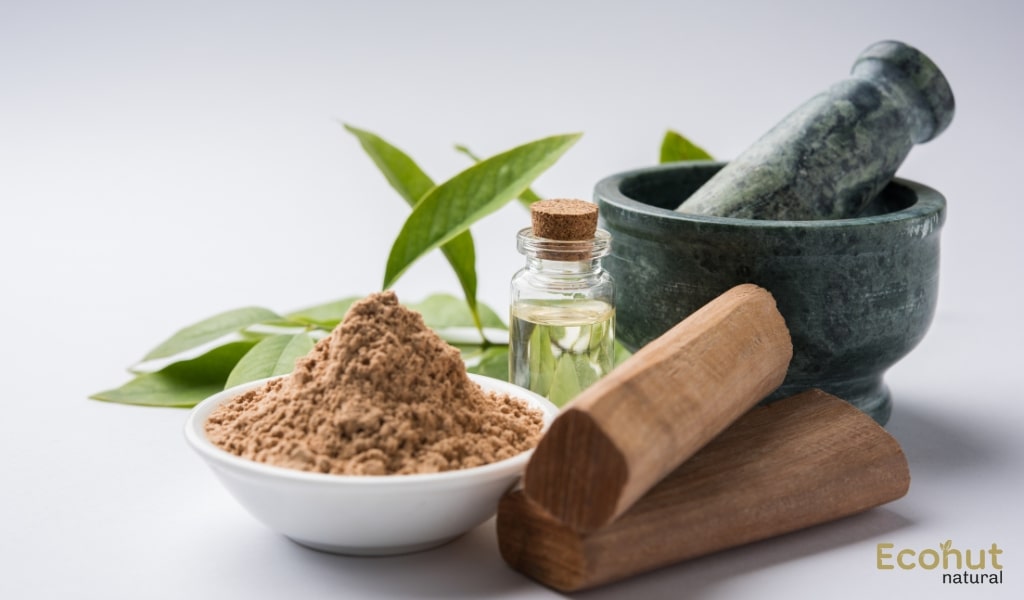“sandalwood” (Santalum Album) describes the heartwood (wood) of tree species that are members of the genus Santalum and family Santalaceae. The evergreen sandalwood tree, which is indigenous to Indonesia and India, can reach heights of 8 to 12 meters and widths of 2.5 meters. The little blooms have several short stalks, and the bark is smooth and gray-brown in hue.
In Ayurveda, sandalwood, also called svetchandan, is sometimes referred to as srigandha. It is one of the rarest and most valuable sources of natural fragrance, having great therapeutic and economic value.
Description
The evergreen tree Santalum album is primarily planted for its wood and essential oil. Antimicrobial and antifungal qualities are just two of its many therapeutic applications.
Botanical Name:
Santalum Album
Family:
Santalaceae
Leaves:
Leaves slender, typically opposite, oblong or ovate elliptical, 3-8 x 3-5 cm, glabrous and bright green above, glaucous and slightly paler beneath
Flowers:
Bisexual flowers, 5–6 mm in diameter, reddish-purple, in terminal paniculate cymes and axillary paniculate cymes, considerably shorter than leaves
Varieties:
White sandalwood, Red sandalwood
Habitat:
Several nations, including Australia, New Zealand, Indonesia, and India, produce chandan. These grow well in sandy, lateritic, and loamy soil from sea level to 1800 meters. The woods of trees that grow on stony hills are highly fragrant.
Part Used:
Bark, Chandan essential oil
Chemical constituents:
The primary components of sandalwood are α- and β-santalol and santenone.
Dosage:
- Powder-3 to 4 grams
- Oil- 5 to 10 drops
- Decoction- 50 to 100 ml
Common Name
Other names for sandalwood include East Indian sandalwood oil, white saunders oil, santal oil, and yellow or white sandalwood oil.
Sanskrit Synonyms
Malayaja, Tilaparnaka, Shveta chandana, Bhadrashri, Gandhasara, Srikhanda, and Chanradyuti
Botanical Description
Sandwood oil is traditionally derived from a small tropical tree called Santalum album, sometimes known as Indian sandalwood. It is indigenous to Southeast Asia and southern India. Other civilizations greatly value its fragrant properties, and other religions, like Hinduism, regard it as sacred.
Other Language Names of Sandalwood (Santalum Album)
English name – sandalwood, sandal tree, sandal, white Indian sandalwood, East Indian sandalwood
Hindi name – safed Chandan, sandal, Chandan
Spanish name – sandalo blanco
Indonesian name – Cendana, chendana, chandan
Italian name – Sandalo Bianco
Sanskrit name – Gosheera, malayaja, tilaparnaka, chandradyuti, Chandan, shreekhanda
Bengali name – Chandan
Gujarati name – sukhada
Punjabi name – Chandan
Kannad name – Chand, shriganda
Malayalam name – candanam
Burmese name – Santagu
Telugu name – Tella Chandanm
Bengali name – srikhanda, Chandan, peetchandan
Tamil name – Sandanam, Chandanm
Scientific Classification
| Kingdom | Plantae |
| Subkingdom | Tracheobionta |
| Superdivision | Spermatophyta |
| Division | Magnoliophyta |
| Class | Magnoliopsida |
| Subclass | Rosidae |
| Order | Santalales |
| Family | Santalaceae |
| Genus | Santalum |
Ayurvedic Properties
Hindi/Sanskrit
- Rasa – Madhura,Tikta
- Guna – Laghu,Rooksha
- Virya – Sheeta
- Vipaka – Katu
English
- Taste – Sweet,Bitter
- Physical Property – Light,Dry
- Potency – Cold
- Metabolic Property (After Digestion) – Pungent
Sandalwood (Santalum Album) Uses
Massaging oil:
Sandalwood oil is frequently used in both traditional massage oil and aromatherapy. When people receive aromatherapy massages, the essential oil helps to reduce anxiety and encourage a soothing impact. The skin appears more radiant and supple after massaging the essential oil into the skin.
Perfumes:
Sandalwood has a persistent, strong, and sweet scent. Its wonderful fixative qualities are used to create high-end fragrances and essential scent oils that promote mental focus. A few drops of this essential oil added to a diffuser or massage oil can have a relaxing effect.
Sandalwood (Santalum Album) Benefits
Urinary tract infection:
In addition to acting as a diuretic by increasing the frequency of urination and eliminating toxic waste from the body, chandan has antibacterial properties that prevent the growth and multiplication of germs in the urinary system.
In Cosmetics:
Ancient literature has recorded the use of sandalwood essential oil for cosmetic purposes. Sandalwood essential oil is one of the greatest and most dependable substances in cosmetics and beauty products because of its extensive medical benefits
Promotes Skin Health:
Sandalwood oil. An imbalance in the Pitta doshas increases the likelihood of acne, blackheads, redness, and irritation of the skin. The benefits of sandalwood oil include improving skin tone, maintaining skin luster and glow, and helping to repair damaged skin cells. Sandalwood oil’s strong astringent, antiseptic, antimicrobial, anti-aging, and disinfecting qualities protect the skin from dangerous bacterial, viral, and fungal infections.
Suntan and Pigmentation Pack:
Apply one teaspoon of a mixture of sandal powder, curd, honey, turmeric powder, and lemon juice equally over the face. After leaving it for ten to fifteen minutes, thoroughly rinse. Tan, dark spots and pigmentation are eliminated with this pack.
Fever:
chandan helps to treat fever and its accompanying symptoms. This herb’s chilly qualities also help the body release heat. As an antipyretic, it decreases body temperature, which in turn lessens fever.
Hair Health:
When it comes to treating hair issues like dandruff and preventing hair loss, sandalwood oil is really beneficial. Sandalwood oil’s potent astringent qualities help repair split ends, prevent excessive sebum production on the scalp, and promote healthy hair growth and luster.
Complexion Pack:
All skin types can benefit from sandalwood powder’s ability to revive their natural beauty and radiance. Create a fine paste by combining one teaspoon of sandalwood powder, one teaspoon besan flour, turmeric powder, and rose water. Apply the mixture evenly over the skin, let it sit for fifteen to twenty minutes, and then thoroughly wash it off. Using this face pack on a daily basis improves the texture, brightness, and fairer complexion of the skin.
Also Read: Bhoj-Patra (Betula Utilis): Uses, Benefits and Properties
Sandalwood (Santalum Album) Side Effects
Skin irritation:
Particularly for those with sensitive skin, sandalwood oil might irritate the skin. Skin irritation symptoms might include burning, itching, and redness.
Kidney damage:
There have been cases of renal damage linked to long-term oral consumption of excessive dosages of sandalwood.
Allergic reactions:
Sandalwood allergies can occur in some persons. An allergic reaction may cause a rash, hives, swelling, and breathing difficulties.
Conclusion
This article concludes that those with pitta dosha imbalances, including those with gallstones, fever, liver disease, sore throats, and other ailments, can benefit from taking chandan. It is safe to use on infants and nursing mothers, but people with asthma should not use it.
FAQS
Is Sandalwood Essential Oil Aromatic?
Yes, sandalwood oil is prized for its ability to intensify scents. This oil’s warm, woodsy scent is mostly utilized in the creation of incense, cosmetics, and fragrances. Its invigorating scent soothes the mind by promoting relaxation in the brain and central nervous system.
Is there any adverse effect of sandalwood?
Yes, sandalwood has a coolant quality; it does have some negative effects on asthmatics.
Which Additional Essential Oils Can Be Mixed With Sandalwood?
Sandalwood oil blends beautifully with floral oils like as jasmine and lavender. It also mixes nicely with citrus oils, such as grapefruit or bergamot. Furthermore, Frankincense oil and sandalwood oil complement each other’s warm qualities.
Is Chandan beneficial to the face?
Yes, Chandan is beneficial to the face.
Is It Safe to Use Sandalwood Powder Every Day on My Face?
Yes, using sandalwood powder on a daily basis is safe and beneficial. Allergists should, however, refrain from taking it as it may cause contact dermatitis.

